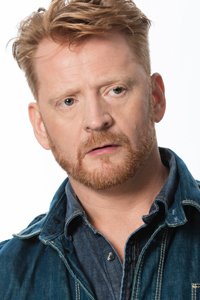
Andy Drachenberg: What makes Wolf Hall’s design so unique?
Christopher Oram: Since we couldn’t possibly create all the locations referred to in both plays the set had to be something much simpler. We had to find a language were we allowed ourselves a simple unit set that told sense of scale rather then specific place. It is church like – a large space, pure lines, and clean. Then we use the costumes to delineate class, character, and location.
AD: What does being both the set and costume designer offer?
CO: In the UK we tend to do both disciplines together. The costumes are deliberately elaborate and the set is deliberately spare in order to show off the costumes. There was never a discussion to be had about how to balance the set and costumes. When I read the play and realized we had to be in Westminster Abbey, the Tower of London, and many other locations. I had to create something visual for the audience to relate to.
AD: When you start working on a piece, is there a certain way you approach working on the project?
CO: My approach is always to understand the writer’s intention. We have both the playwright and the novelist involved with this production, so I can talk to both authors and find out their intentions, ideas, and thoughts for the piece. The novels are saturated in the most explicit detail about the nature of the Tudor world. Hilary has researched it for years and lived with these characters and has created a densely plotted and densely detailed world. The scenes run so quickly into each other and over lap that you don’t have time to set elaborate bits of furniture. I worked with the authors to create a world they believed.
AD: How do you decide what you need and what you don’t need in order to let the audience know what is happening?
CO: There is plenty of space for imagination because we never thought we could actually create all of the locations. Hilary and Mike wrote scenes that explain themselves so the audience is told without having to fly in a sign. You want to work with the writers, lighting designers, and musician in order to tell that story. We use real fire and rain to show that people worked in hardship and freezing cold conditions. There are lots of little pointers and clues without being literal about it.
AD: How do you craft costumes for a show that spans over seven years?
CO: We cut the palette for a lot of the characters straightforward and simple so we could keep them in the background. Boleyn and Henry have very specific costume plots and full costumes changes. They both have ten costume changes that start from youth to age. Henry’s costumes get bigger, bulkier, and more elaborate… Anne starts in a very simple and pretty yellow dress, changes to rich regal purples and gold, switches to more somber tones, and finally ends in a simple black dress… We chart very specific journeys but other characters stay in the same costume every time in order to remind people what character they are.
AD: Where did your inspiration come from?
CO: We look for a medium to build the environment. We chose polished glazed concrete because of its reflective quality but it also has a simplicity and brutalism that works towards the hardness of the world. The materials of concrete and metals offsets the elaborate velvets and rich silks of the costumes nicely.
CHRISTOPHER ORAM (Scenic & Costume Design) recipient of the Tony, Olivier, Evening Standard, Critics Circle, Garland and Ovation awards for his work both here in the U.S. and in the U.K. Recent work on Broadway includes the scenic and costume designs for The Cripple of Inishmann (Cort), Evita (Marquis), Cat on a Hot Tin roof (Richard Rogers) and the Donmar Warehouse productions of Red (Golden), Hamlet with Jude Law (Broadhurst) and Frost/Nixon (Jacobs). Also, Macbeth with Kenneth Branagh (Park Avenue Armoury), King Lear with Derek Jacobi (BAM), and the Glyndebourne production of Billy Budd (BAM)